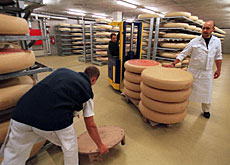Big holes appear in Emmental exports

While sales of most Swiss cheeses are booming abroad, those of traditional favourite Emmental are undergoing a meltdown.
The holey cheese, known as Swiss cheese in North America, is not only suffering from the consequences of a more liberalised domestic market, but also from large-scale foreign competition.
According to figures published by the Swiss Cheese Organisation earlier this month, following a small downturn in 2005, exports of Emmental dropped by 14.5 per cent in the first half of 2006.
In contrast, exports of other Swiss cheeses, such as Gruyère and Tête de Moine, grew by more than ten per cent in the same six-month period.
The figures make for worrying reading in Swiss agricultural circles. Emmental is the top cheese in the country in terms of production and exports and accounts for almost half of all Swiss cheese sold abroad, with sales worth SFr200 million ($163 million).
The most popular Swiss agricultural product worldwide has also become one of Switzerland’s best known symbols.
“In reality, the drop in exports is not due to a lack of interest on the part of consumers, but is due to a production deficit, which currently cannot keep up with demand,” Matthias Kunz, president of the Swiss Cheese Organisation, told swissinfo.
Subsidies
The Emmental “crisis” started at the end of the 1990s, when the government still subsidised exports and production surpluses.
But the gradual liberalisation of the market led in 1999 to the authorities first reducing and then withdrawing their financial support. This, coupled with a slide in prices due to the enormous cheese surpluses that had accumulated over the years, made it difficult for many cheesemakers to survive.
“In 1999 there were still 520 firms producing Emmental. Now there are only just over 200 left in the whole of Switzerland,” said Arthur Fasel, director of Emmentaler Switzerland, the umbrella organisation for Emmental producers.
“The surpluses were eliminated following these structural changes, but now there are hardly any reserves left in the storerooms,” he told swissinfo.
Fasel added that production had nevertheless stabilised over the past few years. Prices have stated to rise again, which should guarantee better profit margins for producers, he said.
But price increases could favour foreign producers, which have been making inroads into the Emmental market. In fact, France and Germany now produce more of the cheese with holes than Switzerland.
The German discounter Lidl recently announced that it would no longer sell the traditional Swiss version, because it is too expensive. It will offer cheaper copies produced in other European countries instead.
Inferior
“These are products of inferior quality. Neighbouring countries do not follow the Swiss production rules, like the cheese being produced using fresh milk, and cows only eating grass or hay and not feed kept in silos,” said Fasel.
“But there are certainly niches in the foreign market which we can still reach with our products.”
This is a practice already followed by other Swiss cheeses such as Vacherin and Tête de Moine. But opposed to these cheeses, Emmental has not yet received the protected designation of origin (AOC) quality label, which protects products from imitations.
An attempt to gain the label was blocked in 2000 after opposition by foreign Emmental makers. However, the cheese is expected to gain the recognition in the next few months. But the delay could cost the industry dearly.
“In Switzerland we certainly started to become interested in the top-end markets too late, letting the foreign competition get bigger. Now it will probably take many more years and intense negotiations before Emmental cheese with the AOC label will be recognised and protected in other European countries,” said Kunz.
“Recently the European Commission did, however, give its opinion on a similar case, that of Feta, only granting Greek cheese the right to carry this name.
“We therefore hope that the same principle will be extended in the future to agricultural products copied in other countries, including Emmental.”
swissinfo, Armando Mombelli
Emmental takes its name from the rural Emmental region in canton Bern. It is also produced in other parts of Switzerland, and in many other countries.
More than 32,000 tons of Emmental were produced in Switzerland last year, about 5,000 tons more than the second-biggest seller, Gruyère.
About three-quarters of Emmental produced was exported.
In 2005 167,706 tons of cheese were produced in Switzerland.
33.6% of it was exported (56,433 tons).
31,508 tons of cheese was imported into Switzerland.
In 2005 the Swiss ate an average of 20 kilograms of cheese per person.

In compliance with the JTI standards
More: SWI swissinfo.ch certified by the Journalism Trust Initiative











You can find an overview of ongoing debates with our journalists here . Please join us!
If you want to start a conversation about a topic raised in this article or want to report factual errors, email us at english@swissinfo.ch.